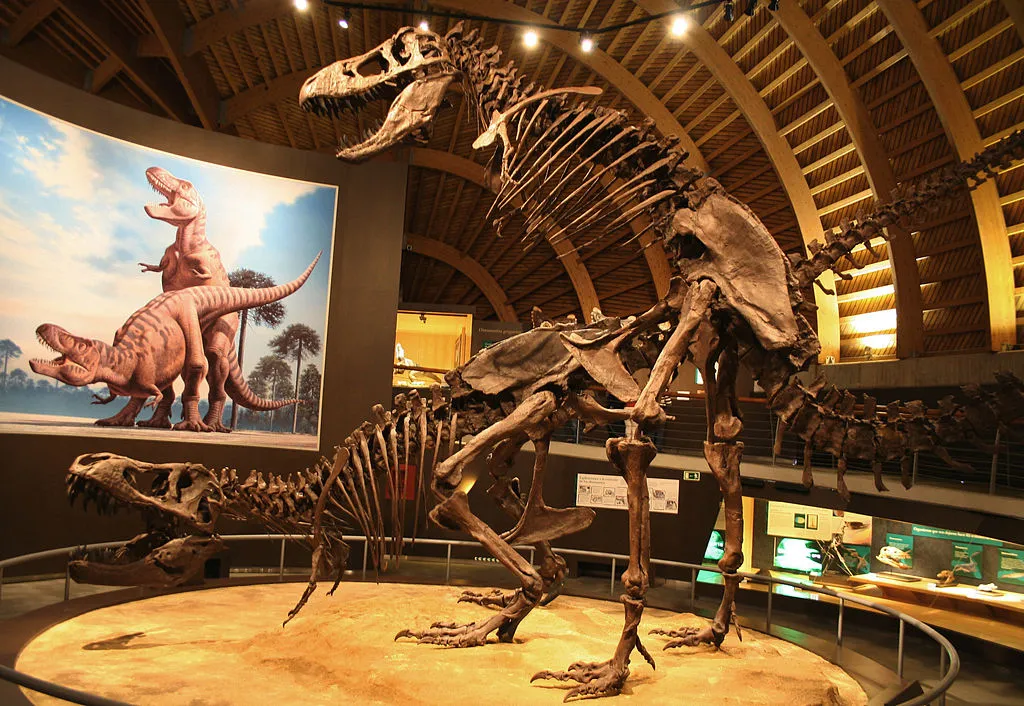Five Things We Don’t Know About Tyrannosaurus Rex
As the Smithsonian welcomes the arrival of its fossil rex, scientists reveal all that we have yet to learn about this magnificent creature
/https://tf-cmsv2-smithsonianmag-media.s3.amazonaws.com/filer/82/81/82814646-f55a-4226-bea7-a3edcb7457f7/img20140411165055.jpg)
At the crack of dawn this morning, a long-awaited Tyrannosaurus rex skeleton, dubbed the Nation’s T. rex, ended its epic road trip, when a 53-foot-long semi pulled up to the loading dock at the National Museum of Natural History in Washington, DC. The arrival of the Nation’s T. Rex marks both the end of the specimen’s long journey from its previous home at the Museum of the Rockies in Bozeman, Montana, and the end of the Smithsonian’s long quest to acquire a T. rex specimen.
Originally named for its discoverer, rancher Kathy Wankel who found it in 1988 in eastern Montana, the fossil was excavated by paleontologist Jack Horner in 1989 to 1990. The 65-million-year-old specimen is one of the most complete T. rex skeletons found. At 38-feet-long and weighing in at 7 tons, the fossil skeleton now called the Nation's T-rex will get its moment in the spotlight, as part of the museum’s dinosaur hall, which will close for renovations on April 28 to reopen again in 2019.
In June of last year, the Smithsonian reached an agreement with the U. S. Army Corps of Engineers, and the skeleton is on loan to the Smithsonian for the next 50 years. At 80 to 85 percent of a full T. rex skeleton, the Wankel T. rex is among the most complete fossils of its kind unearthed, second only to the Chicago Field Museum’s “Sue,” which the Smithsonian tried to acquire in 1997. Beyond these stunning skeletal displays, paleontologists have found some 50 T. rex specimens, since Henry Fairfield Osborn first described the species in 1905.
The king of reptiles, though mighty and well documented in the fossil record, remains largely a mystery to paleontologists who have yet to understand the creature’s basic lifestyle and biology. We've culled scientific reports to bring you five questions that have yet to be answered:
What did T. rex look like? Did it sport scales, colors, feathers or all of the above?
Paleontologists have long debated this. A string of studies in the past decade have pointed to the potential widespread presence of either feathers or fuzz-like proto-feathers in dinosaur species. In 2012, paleontologists found that a T. rex relative, Yutyrannus huali, had filamentous feathers. If a relative had feathers, why not the king of reptiles itself?
Until a specimen is found with preserved imprints of feathers, though, the jury is out. “We have some opportunity to know if they had feathers because we can find impressions,” says Matthew Carrano, curator of dinosaurs at the National Museum of Natural History. “But it’s highly unlikely that we will ever know its color or the texture of its skin.”
Some scientists have proposed methods of predicting dinosaur color based on the shapes of what they believe to be remains of structures that contain melanin, the pigment responsible for darker colors in modern animals. But other researchers suggest that the structures might instead be the remains of bacterial colonies. Evidence of T. rex skin—whether from impressions or preserved skin—would obviously shed light on the issue, but so far paleontologists haven’t had any luck there. Having darker colored skin certainly might have been an advantageous camouflage for T. rex as a predator.
Though evidence of skin from many other ancient reptiles exists in the fossil record, T. rex skin has yet to be discovered, which raises questions of whether it might have been more easily degradable. “It could be something that has to do with feathers in the skin itself changing the texture and the resistance of skin, which perhaps made it more likely to degrade than ‘typical’ scaly skin,” says Mary Schweitzer, a molecular paleontologist at the North Carolina State University who specializes in the remnants of ancient tissue. Schweitzer speculates that the skin of a mature T. rex, “without the feathers, would probably be kind of like chicken legs. Probably scaly, probably pretty resistant to water and degradation at least while they’re alive.”
Chance of an answer? It’s looking more and more likely that T. rex had feathers, but coloration and skin texture remain unknown, for now.
What did T. rex eggs and babies look like?
T. rex juveniles are extremely rare in the fossil record. Some scientists suggest this is because many juveniles survived to adulthood, but it could also be due to a fossil hunters’ bias, to seek out and find big specimens. There’s also the possibility that scientists have simply been misidentifying another related, much smaller species of tyrannosaur, called Nanotyrannus lancensis, that might instead represent T. rex juveniles. Nanotyrannus frequently pops up in the same fossil beds as T. rex, however, a 2010 study examining the skull of a hallmark Nanotyrannus specimen found distinct differences in the sinus and brain casing features. Only further fossil finds will confirm whether Nanotyrannus is a baby T. rex or a distinct species.
As for T. rex babies: Perhaps the young were born with a fluffy feather coat, a common phenomenon in birds, and then lost the majority of their feathers once they reached adulthood. “The bigger you are the harder it is to lose heat,” says Schweitzer. “So, when you’re little, as most critters are when they hatch out, you need insulation or their metabolism would have to be fast enough to maintain body temperature.”
Scientists don’t know if T. rex was totally warm blooded or cold blooded, but they think that the giant’s metabolic rate was probably somewhere in between that of crocodiles and birds. A study published last year in PLOS One suggests that cold blooded energetics could not have fueled dinosaurs’ active lifestyles, and thus they probably didn’t regulate their body temperature exclusively by moving into the sun, as modern lizards and crocodiles are known do. If the PLOS One study is true, it is even more likely that newborns had feathers.
Chance of an answer: The gold standard would be the epic find of a young T. rex inside an egg. No T. rex eggs have ever been discovered, though scientists have stumbled upon eggs from many other dinosaur species. (To you or me, they look like bird eggs.) “We hold out that we can find one,” says Carrano.
What kind of sounds did the king make?
The ominous roar of a T. rex, made familiar by the Jurassic Park movies, is nothing more than the product of a filmmaker’s creative imagination. Scientists look to modern relatives of the T. rex—birds and reptiles—for indications of what the dinosaurs might have sounded like, if they made any vocalizations at all. In reality, their calls may have been more like a shriek or a grumble than a roar. “We can guess that it might have sounded like a crocodile or an ostrich, but definitely not a lion and therefore no roaring or purring,” says Carrano.
Chance of an answer: Nil. The only thing that would prove it is a Mesozoic-era recording of the creature.

How did T. rex get it on?
When Osborn described T. rex in 1905, he posited that the animal’s short forelimb was a “grasping organ in copulation,” forever imprinting the image of two giant reptiles getting it on with grasping tiny arms. If in fact they were feathered, plumage could play a role in precopulatory courting rituals, extending that entertaining image.
In order to pin down the logistics of how these 7-ton animals mated and reproduced, paleontologists need to know which fossils are male and which are female. Unfortunately, T. rex skeletons don’t exhibit a lot of sexually dimorphic characteristics. However, in 2005, Schweitzer found evidence in a Tyrannosaurus rex from the Hell Creek Formation of medullary bone, a type of tissue that accumulates in female birds during ovulation. This type of bone develops to provide calcium to the eggshell. Scientists hypothesized that dinosaurs also had to provide this calcium, and so Schweitzer’s find was a key clue to how T. rex youngsters came to be.
Chance of an answer: “We don’t know the logistics,” says Carrano. “We can theorize; these are pretty big animals—seven-ton animals that stood on two legs.” Scientists might look to giraffes or elephants, but they obviously aren’t perfect models.

What did T. rex use its arms for?
The mysterious function of T. rex’s short arms has provided an endless source of amusement on the internet. But scientists too have been perplexed by the dichotomy of such a large animal with such tiny, seemingly useless forelimbs. Similar to the initial idea that T. rex used its arms to hold its mate, some have suggested that the arms kept prey in place—a study from 1990 hypothesized that the arms could maneuver at least 400 pounds—or provided lift when the animal stood up on two legs, assuming the animals ever sat on the ground.
As far as current theories go, the idea that T. rex’s forelimbs are in fact totally useless is growing in popularity, says Sara Burch, a paleontologist at Ohio University. But Burch isn’t convinced and is trying to reconstruct the muscle layout of T. rex’s forelimbs based on the forelimb muscles of its modern relatives and the shape of the bones.
Chance of an answer: Not out of the realm of possibility. “I think with the new methods of muscle reconstruction and 3D modeling out there, we will definitely narrow down the possibilities of uses for the forelimb,” says Burch. The Nation’s T. rex contains one of most complete forelimbs in the fossil record. “That could lead us to something,” says Carrano.
Though the dinosaur hall will be closing on April 28, visitors will still get a peak at the Nation's T. rex from April 15 through October 20. In a special room at the National Museum of Natural History dubbed "the Rex room," museum conservationists will document, photograph, 3D-scan and store the skeleton before it is shipped off for exhibit assembly. The museum will also feature a number of other exhibits on T. rex paleontology, conservation and the renovation of the dinosaur hall. Smithsonian Associates will also be holding a special evening lecture on the Nation's T. rex on April 17.
/https://tf-cmsv2-smithsonianmag-media.s3.amazonaws.com/accounts/headshot/Screen_Shot_2014-01-27_at_12.05.16_PM.png)


/https://tf-cmsv2-smithsonianmag-media.s3.amazonaws.com/accounts/headshot/Screen_Shot_2014-01-27_at_12.05.16_PM.png)